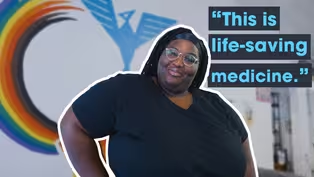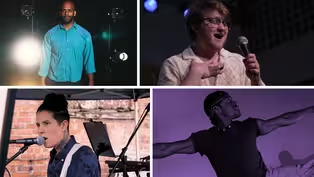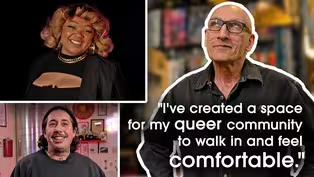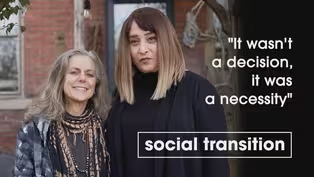
Authentic Lives: Art, Expression, and Identity
11/29/2023 | 7m 20sVideo has Closed Captions
Art is often an expression of one’s true self, a medium utilized by many queer individuals
Art is often an expression of one’s true self – a medium utilized by many individuals in the queer community to explore their identities. Meet two Pittsburgh area artists whose work provides insight and understanding into the experiences of LGBTQIA+ artists. "Authentic Lives: Art, Expression, and Identity" is the second episode of WQED's new series featuring the LGBTQIA+ Community.
Problems playing video? | Closed Captioning Feedback
Problems playing video? | Closed Captioning Feedback
More Local Stories is a local public television program presented by WQED

Authentic Lives: Art, Expression, and Identity
11/29/2023 | 7m 20sVideo has Closed Captions
Art is often an expression of one’s true self – a medium utilized by many individuals in the queer community to explore their identities. Meet two Pittsburgh area artists whose work provides insight and understanding into the experiences of LGBTQIA+ artists. "Authentic Lives: Art, Expression, and Identity" is the second episode of WQED's new series featuring the LGBTQIA+ Community.
Problems playing video? | Closed Captioning Feedback
How to Watch More Local Stories
More Local Stories is available to stream on pbs.org and the free PBS App, available on iPhone, Apple TV, Android TV, Android smartphones, Amazon Fire TV, Amazon Fire Tablet, Roku, Samsung Smart TV, and Vizio.
Providing Support for PBS.org
Learn Moreabout PBS online sponsorshipMore from This Collection
The human experience, diversity, equity, and inclusion is at the heart of each episode, with a focus on the people and organizations making an impact. The ongoing series features those whose work, careers, or everyday lives are leading to positive changes in the LGBTQIA+ community.
Authentic Lives: Community Care
Video has Closed Captions
Hear from the LGBTQIA+ community about healthcare access challenges and the Pittsburgh organizations (8m 36s)
Authentic Lives: How Performance Shapes Identity
Video has Closed Captions
LGBTQIA+ community members have had a long history of involvement in arts and entertainment. (10m 11s)
Authentic Lives: Business and Community
Video has Closed Captions
LGBTQ+ owned businesses provide safe havens, while also developing community and culture. (7m 48s)
Authentic Lives: Social Transition
Video has Closed Captions
For much of the transgender community, first steps in transitioning are relatively small. (8m 21s)
Providing Support for PBS.org
Learn Moreabout PBS online sponsorship- [Announcer] This program was made possible with major funding from Central Outreach Wellness Center.
(gentle music) - [Eriko] People will see me and have their own, like, subconscious ideas of how I could be or who I am.
And I don't think it's ever, like, intentionally bad or anything, but those are things that I feel like I'm constantly working against, and then trying to, like, make peace with in some way.
- [Feliks] How can I reach someone?
How do I communicate these ideas with people that probably have never had to think about them before?
It's one thing to make queer art for other queer artists or queer art for other queer people, but trying to make queer art for people who have never had to even think about it, is there a way we can still reach sort of this mutual joy situation rather than just this very defensive stance?
(mellow music) (mellow music continues) My name is Eriko Hattori.
I use they/them pronouns.
I'm a queer Japanese American artist who works primarily in painting and printmaking.
I would say the crux of my work is largely based around my experience as a Japanese American person who grew up in West Virginia, And just the queerness is also something that intersects with it because like there's so much that like kind of collides between those two.
Growing up as a queer Japanese person in Morgantown, West Virginia, was pretty alienating.
It's so easy to feel isolated and kind of alone when you're the queer person in a place that's not like a epicenter.
I definitely had some, like, gender-nonconforming, or trans feelings and stuff and, like, queer feelings, but I didn't come out until I was like 23 when I had moved away from, like, Morgantown.
A lot of the work that I'm making in terms of the narrative and imagery, in terms of, like, the figures I choose to draw, I try to show and create queer moments of pleasure and pain and intimacy between queer Japanese characters who are, like, ambiguous in their gender.
My work has a lot of bright colors and big contrasts.
So like whenever I make a work that's color, it's most of the time completely color.
And it's like whenever I do ink it's just very stark black and white and stuff, so I like to create, like, a sense of harshness with the palette and wanting to use these, like, kind of like bright colors that are usually playful, and then, like, kind of subvert them and make them a little bit more ominous or scary in some way.
It makes it really fun just being like, how can I make pink be menacing?
You know what I mean?
The work that kind of showcases my relationship to my queerness and Japanese Americanness are usually the ones with a spider woman.
She's called the Jorogumo, and she's like this character from Japanese mythology that's kind of viewed as like a succubi, or like a succubus, doesn't exactly have a great reputation or a great image, you know?
So I kind of try to reclaim her as more of like a guardian figure or a protective figure.
I feel like a lot of mythos has a lot of roots in patriarchy and kind of just, like, a disregard for identities that are more marginalized or just, like, not as commonplace.
I kind of see her as like a figurehead for the experience of being queer and Japanese and how that kind of gets, like, weird, I guess, so yeah.
(gentle music) - My name is Feliks, I am the director of the Museum of Queer Curiosities.
And I'm a multimedia artist with a focus in printmaking, especially as a means of communicating with folk and sharing.
I think that's all I got.
(laughs) (upbeat music) The Museum of Queer Curiosities is a niche museum.
It is a simulation, it is set dressing, and it is sort of the result of years of work in multimedia in different practices.
I'm from South Texas.
My parents are rather conservative, and so it really became about that.
It's this desperate need to communicate, not just with my parents, that's the start of it, but how do I engage with someone who has never had to think about this stuff before?
The idea for the museum really came from how do I put the viewer in the mindset of being in a spot to receive information?
And the question then evolved into what you do if the information is still not intelligible?
Do you give up on it?
Do you get mad at it?
Is it okay to be confused?
And how that relates to how I express and navigate being queer.
Do I have to go into every single iteration of myself and why I am the way I am in order to justify it or can you just be confused, and we can just exist together?
There's lots of hidden features in the museum and hidden symbols that like if you find a connection in one place and you see it somewhere else, you might be able to make some inference of that.
It's like a little a reward for navigating the maze.
So you're there to learn something, you're there to experience something.
I didn't want my name on the wall.
I didn't want an artist's statement.
I didn't want a vinyl title just plastered on the wall.
I wanted this to really feel like more of a niche museum so that when the viewer came in, they could immediately kind of assume their role in this performance as well.
If the facade falls away and it reads more as art gallery, even visually, then I'm probably not succeeding in the goal.
They have to buy into that simulation.
They have to buy in to playing pretend for a little bit, and I think that's very in line with gender too.
Like, we're all just kinda making it up as we go.
(gentle music) - The fact that I make these works and that has been able to connect with people who are also making art in similar veins, or also just being able to like reach out to people and who are just like this work really resonates with me.
And, like, hearing that kind of feedback is just so, so valuable and, like, amazing.
- We're all just made up of our individual experiences and that's the sum of who we are.
Experiencing a single piece of art or talking to one person can have such a drastic impact, like a butterfly effect on, like, who we are as a person, even if we don't realize it.
It really can only survive if there are other queer voices in it, and other queer educators, activists, and even artists present in sharing their voice.
You know, I'm only one queer identity.
- [Eriko] The fact that I'm making stuff that is touching people really is what brings me, like, a lot of joy, and I feel like that's where a lot of the joy comes through.
(mellow music) - [Announcer] This program was made possible with major funding from Central Outreach Wellness Center.
Support for PBS provided by:
More Local Stories is a local public television program presented by WQED

















